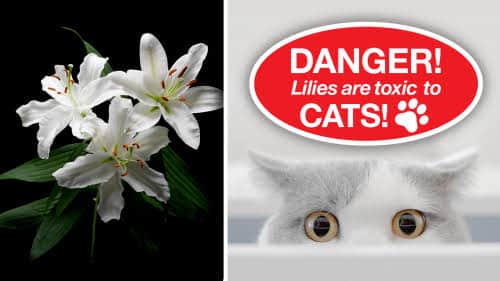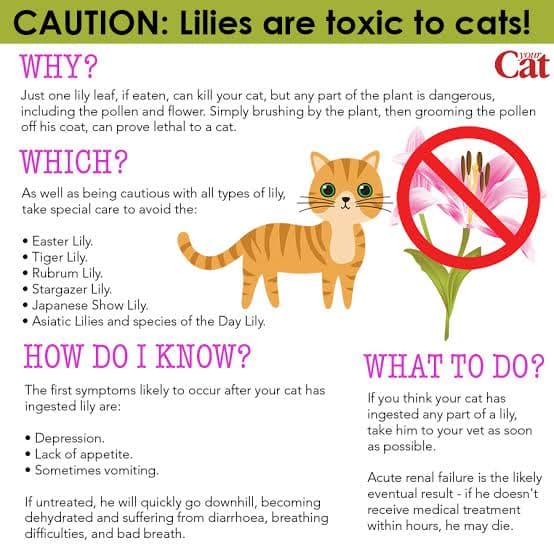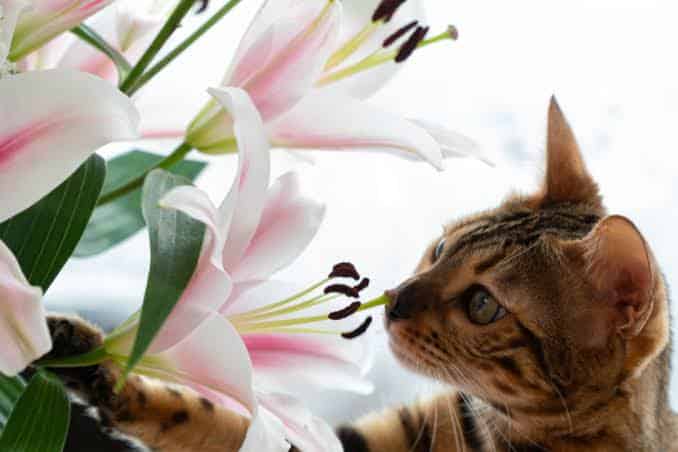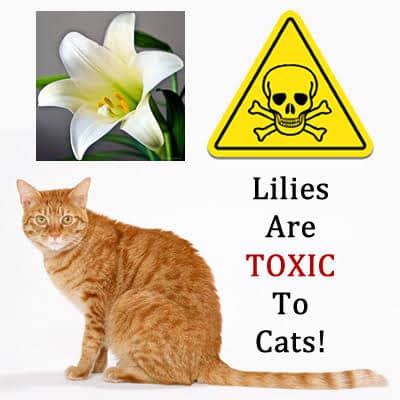Welcome to our insightful exploration into the world of feline safety – a crucial concern for every cat owner. In this article, we delve into the topic “Are Lilies Toxic To Cats: Find Out If Lilies Affects Your Cat”. Other subtopics we shall discuss are; Types Of Lilies And Toxic Compound, Recognizing Lily Poisoning Symptoms, Risks And Consequences Of Lily Ingestion For Cats, Prevention Of Lily Consumption For Cats, etc.
Unraveling the potential risks these elegant flowers pose, we aim to empower cat parents with essential knowledge, ensuring a secure and toxin-free environment for their beloved feline companions. Join us in understanding the importance of this information and how it can safeguard your cat’s well-being.
Types Of Lilies And Toxic Compound
Lilies are a popular choice for gardens and floral arrangements, known for their vibrant colors and elegant appearance. However, it’s crucial to be aware of the potential risks they pose, especially to our feline friends. Below are the various types of lilies and the specific toxins that can be harmful to cats.
Easter Lily (Lilium longiflorum):
- Known for its trumpet-shaped white flowers.
- Commonly associated with spring celebrations.
- Particularly toxic to cats, causing kidney failure.
Tiger Lily (Lilium lancifolium):
- Distinctive orange petals with dark spots.
- Contains substances harmful to cats if ingested.
Daylilies (Hemerocallis spp.):
- Various colors and adaptable to different climates.
- While less toxic than true lilies, they can still cause mild reactions in cats.
Asiatic Lily (Lilium asiatica):
- Diverse colors and popular in gardens.
- Contains toxins affecting cats’ kidneys.
See Also: Are Snake Plants Toxic To Cats: See How Snake Plants Can Affect Cats

Toxic Compounds In Lilies
Lilies contain substances called glycosides, with the primary culprit being the nephrotoxic agent. Here are specific toxins found in lilies that pose a threat to cats:
Lilium And Hemerocallis Species Toxins:
- Both types of lilies contain compounds affecting the urinary system in cats.
- Ingestion can lead to symptoms like vomiting, lethargy, and, if untreated, kidney failure.
Chemical Composition:
- The toxic compounds in lilies are alkaloids, such as colchicine and lycorine.
- These substances interfere with cellular function and can have severe consequences for cats.
Preventive Measures:
- Place lilies in areas inaccessible to cats, both indoors and outdoors.
- Raise awareness about the dangers of lilies among pet owners.
- If a cat shows any signs of lily poisoning, seek immediate veterinary assistance.
Recognizing Lily Poisoning Symptoms
Lilies, particularly those belonging to the Lilium and Hemerocallis species, contain substances that are highly toxic to cats. Ingesting any part of the plant, including the leaves, flowers, pollen, or even the water in the vase, can lead to severe health issues.
Common Signs Of Lily Toxicity In Cats
Vomiting: One of the initial signs of lily poisoning in cats is persistent vomiting. If you observe your cat vomiting and suspect lily exposure, seek veterinary attention immediately.
Lethargy: Cats affected by lily toxicity may become lethargic or exhibit a lack of interest in usual activities. This noticeable change in behavior should not be overlooked.
Loss of Appetite: A sudden loss of appetite can be indicative of lily poisoning. If your cat refuses to eat or shows disinterest in food, it’s essential to consider potential lily exposure.
Increased Thirst and Urination: Lily toxicity can lead to increased thirst and urination in cats. Monitoring changes in your cat’s water consumption and litter box habits is crucial for early detection.
Dehydration: In severe cases, lily poisoning may cause dehydration. Check for signs such as dry gums, sunken eyes, and lethargy, and seek immediate veterinary attention if you suspect dehydration.
See Also: Grey and White Cat Breeds

Importance Of Early Detection And Veterinary Intervention
Early recognition of lily poisoning symptoms is paramount for a positive outcome. If you suspect your cat has been exposed to lilies, do not wait for symptoms to worsen. Seek immediate veterinary attention, providing details about the potential lily exposure. Time is of the essence, as prompt intervention can prevent irreversible kidney damage and increase the chances of a full recovery.
Risks And Consequences Of Lily Ingestion For Cats
While lilies can add aesthetic appeal to your living space, their ingestion by cats can lead to serious health issues. Here, we will look into the various consequences of lily consumption for cats.
Reaction To Toxic Compounds
Lilies contain toxins that are particularly harmful to cats. The primary culprits are chemical compounds known as alkaloids and glycosides, which can cause severe reactions in a cat’s digestive system when ingested. The ingestion of even small amounts of these substances can lead to adverse effects.
Kidney Damage
One of the most significant consequences of lily consumption in cats is the potential for kidney damage. The toxins found in lilies can cause acute kidney injury, a condition that can manifest rapidly and, if left untreated, lead to irreversible damage. Common symptoms include vomiting, loss of appetite, lethargy, and increased thirst.
Gastrointestinal Distress
Cats that nibble on lilies may experience immediate gastrointestinal distress. This can include symptoms such as drooling, abdominal pain, and diarrhea. These signs should not be ignored, as they may be indicative of the ingestion of toxic compounds.
Fatal Consequences
In severe cases, lily toxicity can be fatal for cats. The kidneys play a vital role in filtering toxins from the body, and when they become compromised, the overall health of the cat is at risk. Prompt veterinary intervention is crucial to prevent irreversible damage and improve the chances of survival.
See Also: The Top 9 Best Cat Feeders in 2024

Safe Alternatives And Pet-Friendly Plants
Creating a pet-friendly environment at home involves not only avoiding harmful plants like lilies but also incorporating greenery that is safe for your feline friends. In this guide, we’ll explore a variety of cat-friendly plants, ensuring a lush and secure atmosphere for both you and your beloved pets.
Spider Plant (Chlorophytum comosum):
- Known for its air-purifying qualities, the spider plant is non-toxic to cats.
- Easily grown both indoors and outdoors, making it a versatile choice for any living space.
- Keep in mind that some cats may find the long, arching leaves tempting to play with, so monitor their interactions.
Areca Palm (Dypsis lutescens):
- This palm species adds a tropical touch to your space without posing a threat to your cat.
- Thrives in indirect light and can be placed in various rooms, enhancing the aesthetic appeal of your home.
Boston Fern (Nephrolepis exaltata):
- An attractive hanging plant that’s safe for cats and helps improve air quality.
- Requires consistent moisture, making it an excellent choice for bathrooms or kitchens with higher humidity levels.
Calathea (Calathea spp.):
- Calatheas come in various striking patterns and colors, adding a decorative element to your home.
- Non-toxic to cats, these plants prefer indirect light and consistently moist soil.
African Violet (Saintpaulia spp.):
- With vibrant, colorful flowers, African violets are a visually appealing and safe option for cat owners.
- Compact size makes them suitable for smaller spaces, such as windowsills or tabletops.
Bamboo Palm (Chamaedorea seifrizii):
- A low-maintenance and non-toxic plant, the bamboo palm thrives in low light conditions.
- Perfect for cat owners seeking a touch of greenery in areas with less natural light.
Catnip (Nepeta cataria):
- A cat-friendly classic, catnip is safe for feline companions and can provide them with entertainment.
- Easily grown indoors or outdoors, catnip is a hardy plant that requires minimal care.
See Also: Choosing The Right Wood Cat Litter: A Guide To Optimal Pet Care

Prevention Of Lily Consumption For Cats
It is important to note that prevention is key when it comes to keeping your feline companions safe from the potential dangers of lily consumption. You need to explore the practical and effective strategies to ensure that your home remains a secure environment for your cats. As a result of this, it minimizes the risk of accidental exposure to toxic lilies.
Plant Placement:
Keep lilies out of reach: Place lily plants in areas that are inaccessible to your cats, such as high shelves or hanging planters.
Be cautious with cut flowers: If you receive lilies as a bouquet, display them in locations your cat cannot reach, and consider removing toxic flowers altogether.
Educate Yourself:
Know your plants: Familiarize yourself with the various species of lilies that are toxic to cats, including Easter lilies, Tiger lilies, Asiatic lilies, and Day lilies.
Regularly check your plants: Ensure that all plants in your home, especially those known to be toxic, are regularly inspected for any signs of damage or ingestion.
Create Cat-Friendly Zones:
Designate safe areas: Establish spaces in your home where your cats can explore without the risk of encountering harmful plants.
Provide alternatives: Introduce cat-friendly plants or grasses in these designated areas to satisfy your cat’s natural curiosity.
Supervision and Monitoring:
Watch for signs of curiosity: Keep an eye on your cats when introducing new plants to the environment, as they may be curious about unfamiliar foliage.
Monitor behavior changes: If you notice any sudden changes in your cat’s behavior, such as vomiting, lethargy, or changes in appetite, seek veterinary attention promptly.
Consult with Your Veterinarian:
Discuss plant safety: During regular veterinary check-ups, talk to your veterinarian about the plants in your home and inquire about any potential risks.
Emergency information: Have the contact information for your veterinarian and a local emergency animal poison control hotline readily available in case of accidental exposure.
Use Deterrents:
Bitter-tasting deterrents: Apply safe, bitter-tasting deterrents to the leaves of toxic plants to discourage cats from nibbling on them.
Pet-friendly alternatives: Consider using safe alternatives like citrus peels or diluted vinegar as natural deterrents.
See Also: 15 Cat Behaviors you didn’t know about
Emergency Measures For Cat Consumption Of Lilies
Discovering that your cat has ingested lilies can be a distressing situation, but swift and informed action is key to ensuring the best possible outcome. Below are detailed emergency measures you can take if your cat has consumed lilies, emphasizing the importance of quick intervention to safeguard their health.
Identification and Time Sensitivity
- Promptly identify the type of lily ingested, as different varieties contain varying levels of toxins.
- Note the time of ingestion, as the urgency of your response can be influenced by how recently your cat consumed the lilies.
Contact Your Veterinarian Immediately
- Call your veterinarian as soon as you suspect lily ingestion. Provide detailed information about the type of lily, the quantity ingested, and your cat’s weight.
- Follow any specific instructions given by your vet, which may include inducing vomiting at home.
Inducing Vomiting At Home
- If advised by your veterinarian and within the recommended time frame, induce vomiting using hydrogen peroxide.
- Administer the peroxide as directed, considering your cat’s size and health status. Ensure a calm environment to minimize stress.
Emergency Animal Poison Control
- Reach out to an emergency animal poison control hotline for immediate guidance and support.
- Provide essential details such as your cat’s weight, the type of lily ingested, and any symptoms observed.
Evidence Collection:
- If possible, collect a sample of the lily or any plant material your cat has vomited.
- This evidence can aid in identifying specific toxins and guide your veterinarian in determining appropriate treatment.
Encourage Hydration:
- Encourage your cat to drink water to help flush toxins from their system.
- Your veterinarian may recommend additional supportive care, including intravenous fluids to prevent dehydration and support kidney function.
Close Monitoring and Observation:
- Observe your cat closely for any signs of distress or adverse reactions.
- Note changes in behavior, appetite, and litter box habits, and promptly communicate these to your veterinarian.
Follow-Up Veterinary Care:
- Schedule a follow-up appointment with your veterinarian to monitor your cat’s recovery.
- Additional tests may be necessary to assess kidney function and ensure there are no lingering effects from the lily ingestion.
See Also: 10 Beautiful Black Cat Breeds you can Adopt
Veterinary Insights And Treatment Options
When it comes to lily toxicity in cats, understanding the insights from veterinarians and the available treatment options is crucial for a swift and effective response. Here, we’ll explore the expertise of veterinary professionals and the various treatment measures they may employ to address lily ingestion in feline companions.
Veterinary Insights On Lily Toxicity In Cats
Recognizing Symptoms:
Veterinarians emphasize the importance of recognizing early signs of lily toxicity in cats. Common symptoms include vomiting, lethargy, loss of appetite, and increased thirst.
Timely identification of these signs can significantly impact the success of treatment.
Specific Lilies and Their Impact:
Veterinary experts highlight the different types of lilies that pose a threat to cats, including Easter lilies, Tiger lilies, Asiatic lilies, and Day lilies.
Understanding the specific toxic compounds in these lilies helps veterinarians tailor their treatment approaches.
Kidney Damage Assessment:
Veterinarians assess the extent of kidney damage in cats exposed to lily toxicity. Blood tests, urinalysis, and imaging may be employed to evaluate the severity of the condition.
Early detection allows for more targeted and effective treatment.
Treatment Protocols:
Activated charcoal administration is a common initial step to limit the absorption of toxins in the digestive system.
Intravenous fluids play a crucial role in preventing dehydration and aiding in the elimination of toxins from the kidneys.
Medications to control vomiting and supportive care measures may be implemented based on the individual case.
Collaborative Approach With Pet Owners
Collecting Information:
Veterinarians collaborate with pet owners to gather critical information about the lily ingestion incident. Details such as the type of lily, quantity ingested, and time of ingestion guide treatment decisions.
Providing accurate information enhances the veterinarian’s ability to tailor the treatment plan.
Monitoring and Follow-Up:
Close monitoring of the cat’s vital signs, hydration levels, and overall response to treatment is crucial.
Veterinarians may recommend follow-up appointments to assess long-term kidney function and address any lingering effects of lily toxicity.
See Also: Choosing The Best Elevated Cat Bowls For Optimal Cat Comfort
Conclusion
The insights provided in this guide shed light on the risks associated with various types of lilies, emphasizing the importance of proactive measures to safeguard your cat’s well-being. From recognizing early symptoms to implementing emergency measures and seeking prompt veterinary assistance, being informed empowers cat owners to create a safe environment for their beloved pets.
Whether it’s identifying safe alternatives, preventing lily exposure, or responding swiftly in emergencies, the welfare of our feline companions remains at the forefront. By staying informed about lily toxicity in cats and incorporating the recommended practices into our daily lives, we can ensure a secure and thriving environment for our cats.

